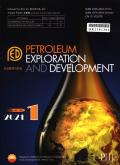Fracture parameter diagnostic method during staged multi-cluster fracturing based on distributed temperature sensing
IF 8
Q1 ENERGY & FUELS
引用次数: 0
Abstract
The Carter model is used to characterize the dynamic behaviors of fracture growth and fracturing fluid leakoff. A thermo-fluid coupling temperature response forward model is built considering the fluid flow and heat transfer in wellbore, fracture and reservoir. The influences of fracturing parameters and fracture parameters on the responses of distributed temperature sensing (DTS) are analyzed, and a diagnosis method of fracture parameters is presented based on the simulated annealing algorithm. A field case study is introduced to verify the model's reliability. Typical V-shaped characteristics can be observed from the DTS responses in the multi-cluster fracturing process, with locations corresponding to the hydraulic fractures. The V-shape depth is shallower for a higher injection rate and longer fracturing and shut-in time. Also, the V-shape is wider for a higher fracture-surface leakoff coefficient, longer fracturing time and smaller fracture width. Additionally, the cooling effect near the wellbore continues to spread into the reservoir during the shut-in period, causing the DTS temperature to decrease instead of rise. Real-time monitoring and interpretation of DTS temperature data can help understand the fracture propagation during fracturing operation, so that immediate measures can be taken to improve the fracturing performance.
基于分布式温度传感的分段多簇压裂裂缝参数诊断方法
Carter模型用于描述裂缝扩展和压裂液漏出的动态行为。建立了考虑井筒、裂缝和储层流体流动和换热的热-液耦合温度响应正演模型。分析了压裂参数和裂缝参数对分布式温度传感(DTS)响应的影响,提出了一种基于模拟退火算法的裂缝参数诊断方法。通过实例验证了模型的可靠性。在多簇压裂过程中,DTS响应具有典型的v型特征,其位置与水力裂缝相对应。v形深度较浅,注入速率较高,压裂和关井时间较长。此外,v型裂缝越宽,裂缝表面泄漏系数越高,压裂时间越长,裂缝宽度越小。此外,在关井期间,井筒附近的冷却效应继续扩散到储层中,导致DTS温度下降而不是上升。DTS温度数据的实时监测和解释有助于了解压裂作业过程中裂缝的扩展情况,以便及时采取措施提高压裂性能。
本文章由计算机程序翻译,如有差异,请以英文原文为准。
求助全文
约1分钟内获得全文
求助全文

 求助内容:
求助内容: 应助结果提醒方式:
应助结果提醒方式:


